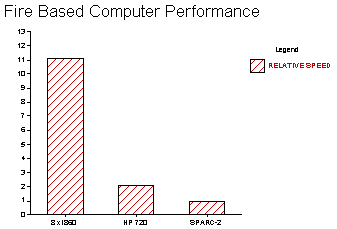FIRE FIELD MODELLING ON PARALLEL COMPUTERS
The relevance of scalable parallel computation to the development of fire field modelling, lies in its ability to perform lengthy calculations in a fraction of the time previously practical, and to provide the fire engineer with the desk-top capability to tackle practical, complex and demanding simulations. The experience of the Fire Safety Engineering Group at the University of Greenwich in developing and using fire field models for use on parallel computers is described here.
The CFD calculations which are the basis of fire field modelling require hundreds of hours of computation on modern workstations and many tens of hours on supercomputers. The reason for this prodigious consumption of computer power is found at the very heart of fire field modelling. This is the need to perform a large number of interactions of the flow solution procedure on fine grids and complex geometries in order to converge a notoriously unstable buoyancy driven flow field.
A recent example based on a SUN SPARC-2 workstation illustrates this point. Three-dimensional calculations comprising 30,360 cells required in excess of 350 hours (2 weeks!) of computer time to perform a 60 second simulation of fire aboard a small aircraft. And using data from a CFD based benchmark, it is estimated that similar calculations performed on the HP-720, one of the most powerful workstations currently available, would require 174 hours.
Faced with these time scales and their associated costs, practitioners are forced to reduce the physics content of their models, settle for coarse grids or examine a reduced parameter space. In practice, it is not uncommon for all three options to be necessary.
Parallel computing techniques offer a low cost means of reducing these running overheads. The attraction of parallel computer architectures lies in their potential to provide low cost supercomputer performance in the solution of numerically-intensive problems. The philosophy of parallel computing is easy to understand. No matter how fast a single processor can work, if one can efficiently utilise several of them simultaneously on a single task, the simulation will be completed in a shorter time.
The Centre for Numerical Modelling and Process Analysis at the University of Greenwich has produced a parallel implementation of the general purpose CFD code CFX. The Fire Safety Engineering Group routinely use this code as the basis for its large scale fire field simulations.
The strategy employed is based on the systematic partitioning of the computational domain. However, to the fire field modeller, there appears to be no difference in using the parallel and conventional version of CFDS-FLOW3D.
The parallel computer used by the Fire Safety Group is a distributed memory system comprised of 12 Intel i860 microprocessors.
The performance capabilities of the parallel fire code are demonstrated through a simulation of a fire aboard a single aisle commuter aircraft containing 29 seats and two exits. In this simulation 101,200 cells were used with a time step of 0.1 seconds. Using 8 i860s, the first 2 seconds of the simulation required 9.6 hours. This represents an approximate speed-up of 11.11 over the SPARC2, and using the CFDMARK data, an estimated speed-up of 5.4 over the HP720. This case could not be run on the SPARC2 because of insufficient memory, hence the speedup figure represents a lower bound estimate. Based on these figures, the 60 second simulation would require an estimated 12 days on the parallel machine, 133 days on the SPARC2 and 64 days on the HP720.

FIGURE: Estimated relative performance of Parallel i860 system, HP720, and SPARC2 workstations in performing 101,200 cell fire field simulation.
For more recent developments click here
Reference:
E R Galea, N Hoffmann and D Berhane. Large-Scale Fire Field Modelling - the Route to General Use via Parallel Processing. Proceed INTERFLAM '93, Oxford, 1993.
See publications # 56, 55, 50, 44, 43.

